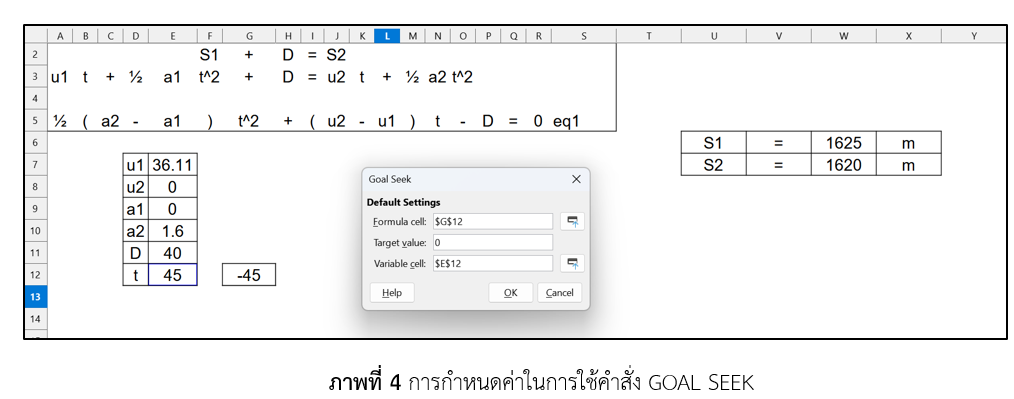การจำลองการเคลื่อนที่ของวัตถุสองวัตถุที่เคลื่อนที่ไล่ตามกันในแนวตรงโดยใช้ลิบราออฟฟิส
Main Article Content
บทคัดย่อ
ในงานวิจัยนี้ผู้วิจัยได้เสนอการใช้โปรแกรมตารางจัดการ (spread sheet) ชื่อ ลิบราออฟฟิศ (LibreOffice) ซึ่งเป็นโปรแกรมที่ไม่มีค่าใช้จ่ายในการจำลองเหตุการณ์ (simulation) ของปัญหาการเคลื่อนที่ในแนวตรงของวัตถุสองวัตถุที่เคลื่อนที่ไล่ตามกัน (two-body pursuit problem) และเสนอการใช้ฟังก์ชันสำเร็จรูป GOAL SEEK ในการหาค่าเวลาที่วัตถุต้องใช้ในการไล่ตามอีกวัตถุหนึ่งให้ทัน ผู้วิจัยพบว่าสามารถใช้โปรแกรมลิบราออฟฟิศ ในการจำลองเหตุการณ์ และสามารถใช้ประมาณค่าคำตอบของสมการการเคลื่อนที่ได้โดยไม่ต้องใช้การเขียนโปรแกรมที่ซับซ้อน เหมาะที่จะใช้เป็นเครื่องมือช่วยในการเรียนรู้ด้วยตนเองของนักศึกษา นอกจากนี้ผู้สอนยังสามารถใช้ในการสร้างแบบทดสอบที่หลากหลายได้โดยการปรับค่าตัวแปรตั้งต้น
Article Details

อนุญาตภายใต้เงื่อนไข Creative Commons Attribution-NonCommercial-NoDerivatives 4.0 International License.
วารสารวิทยาศาสตร์และวิทยาศาสตร์ศึกษา (JSSE) เป็นผู้ถือลิสิทธิ์บทความทุกบทความที่เผยแพร่ใน JSSE นี้ ทั้งนี้ ผู้เขียนจะต้องส่งแบบโอนลิขสิทธิ์บทความฉบับที่มีรายมือชื่อของผู้เขียนหลักหรือผู้ที่ได้รับมอบอำนาจแทนผู้เขียนทุกนให้กับ JSSE ก่อนที่บทความจะมีการเผยแพร่ผ่านเว็บไซต์ของวารสาร
แบบโอนลิขสิทธิ์บทความ (Copyright Transfer Form)
ทางวารสาร JSSE ได้กำหนดให้มีการกรอกแบบโอนลิขสิทธิ์บทความให้ครบถ้วนและส่งมายังกองบรรณาธิการในข้อมูลเสริม (supplementary data) พร้อมกับนิพนธ์ต้นฉบับ (manuscript) ที่ส่งมาขอรับการตีพิมพ์ ทั้งนี้ ผู้เขียนหลัก (corresponding authors) หรือผู้รับมอบอำนาจ (ในฐานะตัวแทนของผู้เขียนทุกคน) สามารถดำเนินการโอนลิขสิทธิ์บทความแทนผู้เขียนทั้งหมดได้ ซึ่งสามารถอัพโหลดไฟล์บทความต้นฉบับ (Manuscript) และไฟล์แบบโอนลิขสิทธิ์บทความ (Copyright Transfer Form) ในเมนู “Upload Submission” ดังนี้
1. อัพโหลดไฟล์บทความต้นฉบับ (Manuscript) ในเมนูย่อย Article Component > Article Text
2. อัพโหลดไฟล์แบบโอนลิขสิทธิ์บทความ (Copyright Transfer Form) ในเมนูย่อย Article Component > Other
ดาวน์โหลด ไฟล์แบบโอนลิขสิทธิ์บทความ (Copyright Transfer Form)
เอกสารอ้างอิง
Cooke, B. (1997). Some ideas for using spreadsheets in physics. Physics Education, 32(2), 80.
Dory, R. (1988). Spreadsheets for physics. Computers in Physics, 2(3), 70-74.
González, M. I. (2018). Lens ray diagrams with a spreadsheet. Physics Education, 53(3), 035016.
Grigore, I., Miron, C. and Barna, E. (2016). Didactic tools created with Excel spreadsheets to study motion on an inclined plane. Romanian Reports in Physics, 68(1), 440-454.
Guerrero, H. and Guerrero, H. (2019). Solver, Scenarios, and Goal Seek Tools. Excel Data Analysis: Modeling and Simulation, 311-346.
Korsun, I., Kryzhanovskyi, S. and Monchuk, M. (2019). The study of thermometers using Microsoft Excel. Physics Education, 54(6), 065004.
Oliveira, M. C. and Nápoles, S. (2010). Using a spreadsheet to study the oscillatory movement of a mass-spring system. Spreadsheets in Education, 3(3), 1-23.
Pornsuriwong, S. and Sungthong, A. (2020). The results of learning activities using STEM education of motion in physics for grade-11 students (in Thai). Journal of Science and Science Education, 3(1), 30-40.
Robinson, G. and Jovanoski, Z. (2011). The use of Microsoft Excel to illustrate wave motion and Fraunhofer diffraction in first year physics courses. Spreadsheets in Education, 4(3), 1-21.
Singh, I. and Kaur, B. (2018). Teaching graphical simulations of Fourier series expansion of some periodic waves using spreadsheets. Physics Education, 53(3), 035031.
Singh, I., Khun, K. K. and Kaur, B. (2018a). Simulating Fraunhofer diffraction of waves using Microsoft Excel spreadsheet. Physics Education, 53(5), 055010.
Singh, I., Khun, K. K. and Kaur, B. (2018b). Visualizing the trajectory of a charged particle in electric and magnetic fields using an Excel spreadsheet. Physics Education, 54(1), 015002.
Uddin, Z., and Zaheer, H.M. (2019). Simulating Physics Experiments in Spreadsheets–Experimenting with Ohm’s Law. The Physics Teacher, 57(3), 182-183.


